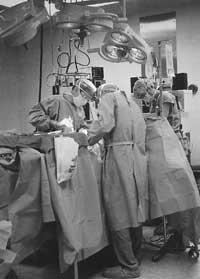Xenotransplant
Why the need for xenotransplant?
In recent years there has been an increase in the number of organ donors of deceased persons in solidarity and altruistic societies. These efforts have meant greater coverage in the treatment of renal, hepatic, cardiac insufficiencies, etc. In addition, transplant medicine is obtaining very satisfactory results in the medium and long term.
But all this is not enough to eliminate the waiting list of patients who need an organ to continue living. Some pathologies, such as kidney failure, may resort to artificial organs during transplant waiting, but others, such as liver or heart failure, do not have the help of the machine to wait for transplantation. Some will continue to live in this wait and others will die.
Do we have enough organs of deceased people for all patients who need organs?
Unfortunately not. And due to the lack of sufficient organs for all patients, transplant candidates must be selected taking into account medical criteria. Professionals should choose the most appropriate patients, that is, to see and make known to the body that the organ works best. And all other patients? Some will never have a transplant organ and others will die in that wait. On the other hand, in some countries organ donation is skyrocketing and fewer people say they don't.

Faced with this situation, a few years ago the research of the xenotransplant was taken so that one day all those who need it have the organ they need. The idea of using animal organs for transplants dates back almost a century ago, overcoming numerous obstacles.
For xenotransplantation goats, sheep, monkeys, baboons, chimpanzees and pigs have been used. It is the animal closest to humans on the phylogenetic scale.
As a transplant organ donor, why more research on pork than chimpanzee?
The pig in phylogeny is slightly below the chimpanzee, but many researchers have replaced the primates with the pig, for very easy to understand reasons. As for the parameters relevant to transplantation, there is a great similarity between pig and man, among other aspects, the physiology and functioning of the kidney, heart and lungs.
The pig is very abundant and grows easily in captivity, primates are scarce, reproduce badly in captivity and take more than 6 years to mature. The pig quickly reaches sexual maturity, has numerous offspring and reaches for a few months the maturity and size of human organs. These characteristics are important when acquiring organs.
Another very important aspect about the advantages of the pig compared to the primate is that related to the contamination of infectious diseases. No contagious disease has been reported in pigs, while primates have infected several viruses in men. There are more chances of having pigs that do not contain specific pathogens for use as xenotransplant donors and it is much easier than the primate for pig management in the laboratory.
Where are the barriers to xenotransplantation today?
Surgery for the implantation of an organ in humans has no technical difficulty and can be performed without major obstacles. Outstanding problems are ethical and other biological, such as the immunological aspects of rejection.
In general, the ethical aspects of xenotransplant have a great distrust in society, although the results of the surveys for patients waiting for transplantation are very different and most do not have any ethical problems to be carriers of an animal organ, for which the most important thing is that the organ works properly. Among the doctors, a medical committee recently asked the University of Pittsburgh (USA) to abandon the transplant program to implement the organs of baboons in humans in view of failures, saying that the xenotransplant has not yet arrived.

In view of this social sensitivity, it is necessary to establish an ethical code of xenotransplant that takes into account the following characteristics: transplanting the organs of the deceased person and comparing the ethics of xenotransplant, animal rights, genetic transfer and manipulation, national, cultural, religious, scientific ethics and, why not, the financing of xenograft. But these regulations should not be stricter than other human behavior standards in order not to limit scientific progress. I believe that science is ahead of human consciousness and, in this specific case, we expect a great goodness of science, where professional deontology and legal regulations will observe the misuse of these great advances of science in sick people.
Another obstacle still unresolved is that related to biological aspects, absolutely dependent on genetic research and molecular engineering. The first problem to solve is hyperacute rejection, i.e. the total destruction of the transplanted organ in the receptor. If every organism has spy substances before the introduction of foreign products and this matter is not known, the monitors are launched immediately to destroy it. The first step is therefore to know the foreign organ, avoiding hyperacute rejection. This has been achieved almost completely and there are already some breeding of transgenic pigs. The lineage of transgenic pigs is becoming increasingly forced to be used as an organ donor, at least as a heart donor.
These genetic engineering maneuvers eliminate substances that cause hyperacute rejection. Organs will be used when everything is correct and chronic rejection with current and future drugs against rejection will be avoided. And as knowledge progresses, and goes fast, we can overcome bespoke organs and the problem of acute and chronic rejection. Thus, xenotransplant dates back to the XXI. At the beginning of the 20th century it will be a normal therapy and all those who need it will have their organ. At present we are asking society to provide free of charge to all patients who need to transplant their organs, since otherwise it has done the same of their life.





